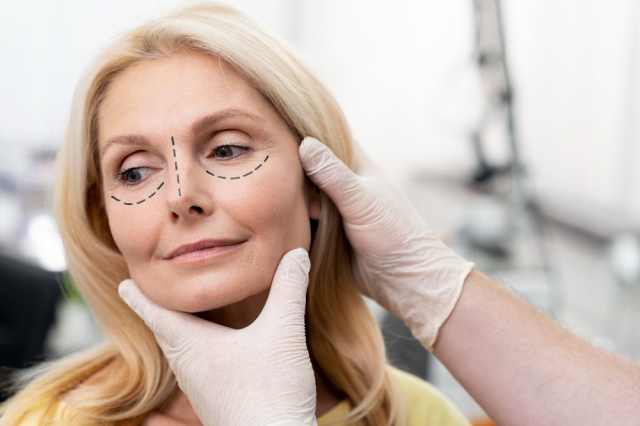Understanding Blepharoplasty
Blepharoplasty, commonly known as eyelid surgery, is a sophisticated cosmetic procedure designed to revitalize the appearance of the eyes. This surgical intervention focuses on removing excess skin, muscle, and sometimes fat from the upper and lower eyelids. The procedure's popularity has surged in recent years, with many individuals seeking to address age-related changes or genetic predispositions affecting their eye area.
The Aging Process and Your Eyelids
As we age, our skin naturally loses elasticity and firmness. This process, coupled with the constant movement of our eyelids, can lead to a variety of aesthetic and functional concerns:
- Sagging upper eyelids
- Puffy lower eyelids
- Excess skin obscuring the natural eyelid fold
- Impaired peripheral vision due to overhanging skin
These changes not only affect one's appearance but can also impact daily life, making tasks like reading or driving more challenging.
Reasons to Consider Blepharoplasty
Aesthetic Motivations
Many individuals opt for blepharoplasty to achieve a more youthful and refreshed appearance. Common aesthetic goals include:
- Reducing the appearance of under-eye bags
- Minimizing crow's feet and fine lines
- Creating a more defined eyelid crease
- Alleviating a perpetually tired or sad expression
Functional Improvements
Beyond cosmetic reasons, blepharoplasty can offer significant functional benefits:
- Expanding the field of vision by removing obstructing excess skin
- Reducing eye strain caused by overcompensating muscles
- Alleviating dry eye symptoms exacerbated by eyelid positioning
Boost in Self-Confidence
The eyes are often described as the windows to the soul, playing a crucial role in how we perceive ourselves and how others perceive us. A rejuvenated eye area can lead to:
- Increased self-esteem
- Improved social interactions
- A more positive self-image in personal and professional settings
The Blepharoplasty Procedure
Types of Blepharoplasty
- Upper Eyelid Blepharoplasty: Focuses on removing excess skin and fat from the upper eyelids.
- Lower Eyelid Blepharoplasty: Addresses bags under the eyes and excess skin on the lower lids.
- Double Eyelid Surgery: Creates or enhances an eyelid crease, popular in Asian blepharoplasty.
The Surgical Process
The procedure typically involves the following steps:
- Anesthesia administration (local or general)
- Precise incision placement along natural eyelid creases
- Removal or repositioning of excess fat, muscle, and skin
- Meticulous closure of incisions to minimize scarring
Recovery and Results
Recovery from blepharoplasty is generally straightforward:
- Initial swelling and bruising subsides within 1-2 weeks
- Most patients return to normal activities within 10-14 days
- Final results become fully apparent after several months
Choosing the Right Surgeon
Selecting a qualified and experienced surgeon is crucial for achieving optimal results. When searching for "blepharoplasty surgeons near me," consider the following factors:
- Board certification in plastic surgery or ophthalmology
- Extensive experience in eyelid surgeries
- Before-and-after photos of previous patients
- Patient reviews and testimonials
For those in Florida, searching for "blepharoplasty Orlando" can yield a list of reputable surgeons specializing in this procedure.
Preparing for Your Blepharoplasty Consultation
Before meeting with a surgeon, prepare by:
- Gathering your medical history, including any eye conditions
- Listing your medications and supplements
- Preparing questions about the procedure, recovery, and expected outcomes
- Considering your aesthetic goals and how to communicate them effectively
Potential Risks and Complications
While blepharoplasty is generally safe, it's important to be aware of potential risks:
- Dry eyes or difficulty closing eyes completely
- Temporary blurred vision
- Asymmetry between eyelids
- Scarring (although usually minimal)
- Infection (rare)
A thorough discussion with your surgeon about these risks is essential for making an informed decision.
Alternative and Complementary Procedures
In some cases, blepharoplasty may be combined with other procedures for comprehensive facial rejuvenation:
- Brow lift: Addresses forehead wrinkles and elevates sagging brows
- Facelift: Rejuvenates the lower face and neck
- Non-surgical treatments: Botox or dermal fillers can complement surgical results
The Psychological Impact of Blepharoplasty
The decision to undergo blepharoplasty often extends beyond physical changes:
- Improved self-perception can lead to increased confidence in social and professional settings
- A more youthful appearance may align one's outer appearance with their inner vitality
- Addressing functional issues can alleviate stress and improve quality of life
Long-Term Care and Maintenance
To maintain the results of blepharoplasty:
- Protect your eyes from sun damage with sunglasses and sunscreen
- Maintain a healthy lifestyle, including proper nutrition and hydration
- Consider non-invasive treatments to prolong results
- Attend follow-up appointments as recommended by your surgeon
Financing Your Blepharoplasty
While often considered a cosmetic procedure, blepharoplasty may be covered by insurance if it addresses functional issues. Options for financing include:
- Medical credit cards
- Payment plans offered by the surgical practice
- Personal loans or savings
The Future of Blepharoplasty
Advancements in surgical techniques and technology continue to improve blepharoplasty outcomes:
- Minimally invasive approaches reducing recovery time
- 3D imaging for more precise surgical planning
- Combination therapies integrating surgery with non-invasive treatments
Making the Decision
Deciding to undergo blepharoplasty is a personal choice that should be made after careful consideration and consultation with a qualified surgeon. By understanding the procedure, its benefits, and potential risks, you can make an informed decision about whether blepharoplasty is right for you.
Remember, the goal of blepharoplasty is not to completely alter your appearance, but to enhance your natural features and address concerns that may be affecting your quality of life. With the right approach and a skilled surgeon, blepharoplasty can help you achieve a refreshed, rejuvenated look that reflects your inner vitality.






